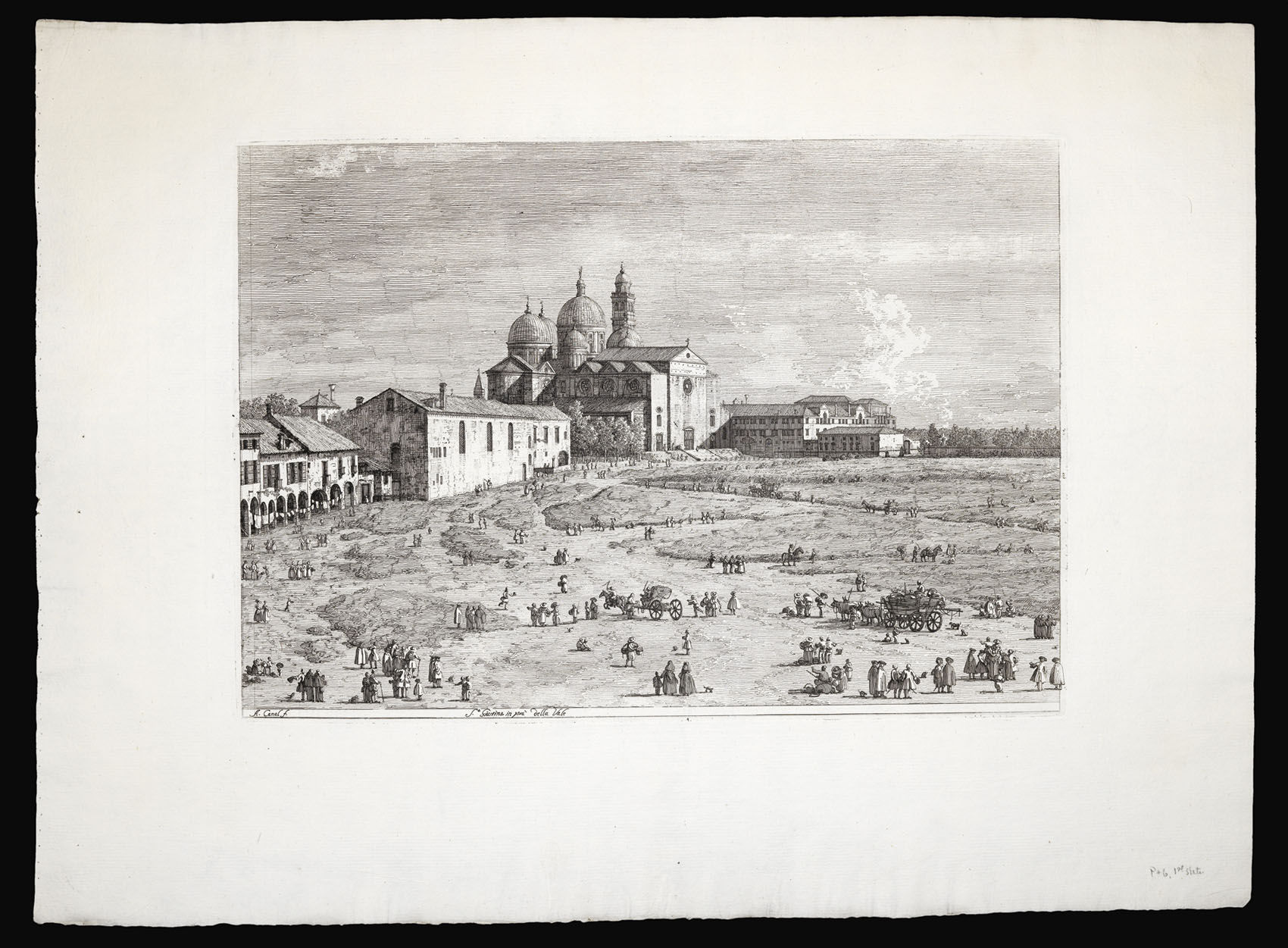



The Prato
St.a Giustina in pra della Vale [WITH:] Pra della Valle.
- 作者: CANALETTO, Antonio
- 出版地: Venice,
- 发布日期: 1741.
- 物理描述: First states. 2 etched plates, (each image size: 300 by 430mm) each with Remondini watermark.
- 方面: 465 by 630mm. (18.25 by 24.75 inches).
- 库存参考: 12724
笔记
Canaletto turned to engraving at the height of his career, when he had received numerous commissions from the likes of Stefano Conti of Lucca, Owen McSwiney - for several English gentlemen - and most notably, by his greatest patron, the collector and Consul of Venice, Joseph Smith.
This expansive view of Santa Giustina in prà della Valle, Padua, is from Canaletto's "Vedute, altre prese da i Luoghi altre ideate da Antonio Canal...", the artist's sole etched work: "views, some taken from nature, some invented, by Antonio Canal, and by him set in perspective, engraved and dedicated to the most illustrious Joseph Smith, Consul of His Britannic Majesty to the Most Serene Venetian Republic, as a sign of homage and esteem."
The present pair of etchings combine to make a magnificent view of the domes of the basilica of Santa Giustina, presiding over the immense square in Padua known as the Prato. They are both printed on paper bearing the Remondini watermark, and as such are particularly rare and only known one or two examples.
Antonio Canal, detto il Canaletto (1697-1768) dedicated the "Vedute" to the consul of Venice Joseph Smith, who may well have commissioned the work. As Bromberg observes, etching was extraordinarily well suited to Canaletto's painterly style, and the pains he bestowed on the plates is evident from his frequent use of re-biting. Whereas his paintings characteristically portrayed the grand buildings of Venice, in the etchings Canaletto expressed his love of the Venetian countryside with its humble buildings and poor inhabitants.
In the 1740s the wars in Europe put a stop to the Grand Tours of his clients; so Canaletto temporarily gave up painting and began etching. The thirty-eight prints he published are among the most attractive etchings ever made. Some are views of particular locations, while the major part were 'capricci' - drawn from his imagination; he was able to invent a different combination of strokes, without any use of cross-hatching, for every surface he depicts, so that every part of his etching is full of interest. Canaletto could make a richly satisfying etching without a grand monument as its subject, unlike his younger compatriot Piranesi. "As his needle passed through the etching ground, it defines form, texture, and shadows in one movement" (Bromberg).
This expansive view of Santa Giustina in prà della Valle, Padua, is from Canaletto's "Vedute, altre prese da i Luoghi altre ideate da Antonio Canal...", the artist's sole etched work: "views, some taken from nature, some invented, by Antonio Canal, and by him set in perspective, engraved and dedicated to the most illustrious Joseph Smith, Consul of His Britannic Majesty to the Most Serene Venetian Republic, as a sign of homage and esteem."
The present pair of etchings combine to make a magnificent view of the domes of the basilica of Santa Giustina, presiding over the immense square in Padua known as the Prato. They are both printed on paper bearing the Remondini watermark, and as such are particularly rare and only known one or two examples.
Antonio Canal, detto il Canaletto (1697-1768) dedicated the "Vedute" to the consul of Venice Joseph Smith, who may well have commissioned the work. As Bromberg observes, etching was extraordinarily well suited to Canaletto's painterly style, and the pains he bestowed on the plates is evident from his frequent use of re-biting. Whereas his paintings characteristically portrayed the grand buildings of Venice, in the etchings Canaletto expressed his love of the Venetian countryside with its humble buildings and poor inhabitants.
In the 1740s the wars in Europe put a stop to the Grand Tours of his clients; so Canaletto temporarily gave up painting and began etching. The thirty-eight prints he published are among the most attractive etchings ever made. Some are views of particular locations, while the major part were 'capricci' - drawn from his imagination; he was able to invent a different combination of strokes, without any use of cross-hatching, for every surface he depicts, so that every part of his etching is full of interest. Canaletto could make a richly satisfying etching without a grand monument as its subject, unlike his younger compatriot Piranesi. "As his needle passed through the etching ground, it defines form, texture, and shadows in one movement" (Bromberg).
参考书目
- Ruth Bromberg, Canaletto etchings, 7-8, first states
图片库
/
 地图
地图  地图集
地图集  珍本
珍本  版画
版画  天文仪器
天文仪器 










